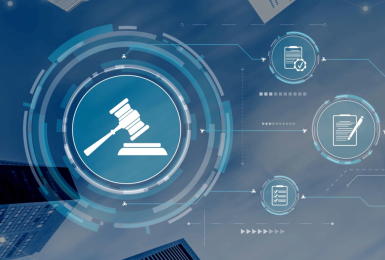Nearly everyone uses a computer today. From phones and tablets to laptops and desktop gaming systems, there's a lot of sensitive data being transferred across the internet every second of every day. This is especially relevant to companies and organizations with employees who access their work’s computer network five or more days a week. Cybersecurity is critical for these organizations, and training employees on cybersecurity best practices is even more vital if systems and data are to remain invulnerable to attack.
Cybersecurity is a dynamic and in-demand field in the twenty-first century. Those who have the proper training and credentials may find doors opening across a vast range of industries. If this sounds like a career you could grow to love, earning your degree in cybersecurity is a solid first step.
Why Cybersecurity Training Is Important for Employees
Cybersecurity is a method of protecting your company's computer network and the sensitive information stored on it from digital attacks. By having simple safeguards in place, a company can help protect home addresses, phone numbers, passwords, banking information, and credit card numbers from being leaked with malicious intent.
If you've ever been a victim of an online data breach, and most of us have, you understand the critical need for cybersecurity in the workplace. Training employees on cybersecurity measures is a simple way to add an extra layer of protection on top of the firewalls and security measures already in place.
Common Cyber Threats and Vulnerabilities in the Workplace
In 2023, hackers have become increasingly more sophisticated, targeting cloud service providers and doubling up on attacks that combine ransomware with data theft. Some of today's more common cybersecurity threats include:
- Phishing: Sending a link from what looks like a trusted source and encouraging users to click, download, or open tainted files
- Malware: Installing malicious code on a company's devices that steals data, destroys data, or cripples hardware
- Ransomware: Encrypting a company's data so they can't access it, then charging a ransom to restore it
- Password attacks: Using advanced software to "guess" user passwords and gain access to their files
- Internal attacks: Someone from inside the company uses their access to cause damage
By keeping their team in the loop regarding new cyber threats and following cybersecurity best practices for employees, a company can greatly reduce its risk of digital attacks.
Safe Browsing Habits and Avoiding Malicious Websites
One of the easiest ways a company can help keep its data protected is by limiting employee access to high-risk websites. This is why many workplace computers can't access sites in certain industries, such as airline travel, publishing, or real estate. Surprisingly, these industries are among the most compromised when it comes to malware.
But even if your company doesn't limit internet access on its computers, it's still wise to steer clear of high-risk sites and email originating from other servers. Doing so could help protect sensitive data and avoid breaches by a malicious attacker.
Software Updates and Keeping Devices Secure
Performing regular maintenance on a computer network is another way companies can help protect their systems and data. Many companies hire a professional with a degree in cybersecurity to keep them safe in this regard. This individual can set up the network securely and then consistently update and maintain it so it's not vulnerable to ever-evolving threats. In many instances, the cybersecurity expert can also repair and re-secure a system that has been breached by an attack.
How to Handle Sensitive Information Securely
The handling of sensitive information, such as credit card numbers and passwords, is another area where training employees in cybersecurity pays off. By learning how to handle this information discreetly and adhering to security protocols, companies can reduce the risk of leaked or stolen data. There are several ways to do this:
- Limit access to sensitive data to only the most trusted employees
- Require strong passwords
- Require two-factor verification
- Conduct intermittent security audits on employees, software, and devices
Companies should train employees not to toss sensitive data into the trash after entering it into the computer. They should also know never to leave sensitive data lying on a desk and never to take it home.
Tips for Password Management and Authentication
Two-factor authentication is immensely helpful in preventing unauthorized usage of credit cards or bank accounts. It requires a password log-in and then a text or a call to a mobile device before access is granted. The follow-up text or call can only be sent to the phone number that's on file with the account. In the event a hacker has the necessary password, they still can't access the account without having the phone where the text is being sent. Companies should use two-factor authentication wherever possible.
A second way employees can help keep accounts secure is by using strong passwords and changing them intermittently. In this way, passwords that are harvested during data breaches will essentially "time out." Hopefully, this happens before a scammer finds time to use them.
Understanding Phishing Scams and How to Avoid Them
Phishing scams are often carried out through emails. A hacker sends an email that looks as though it's official and from a trusted source, such as a bank or a credit card company. The email contains links the user is advised to follow to report suspicious activity or verify a purchase. After clicking the link, the user is prompted to enter sensitive information, such as passwords or account numbers, to verify the account belongs to them. However, they’ve been redirected to a scammer's site that records the entered data.
Companies can avoid falling prey to phishing scams by training employees not to click on links contained in email messages or by blocking emails from outside servers.
Identifying and Reporting Suspicious Activity
When employees run across an activity that seems suspicious, they should have a way to report it. These reports should go to one person, or to a very small group of people, within the company who know how to act on the information. By singling out suspicious activity, the network administrator or cybersecurity expert can then block the attempted breach. It's important that every employee is trained in spotting and reporting suspicious activity right away.
Creating Company-Wide Cybersecurity Policies
Companies should create a culture where cybersecurity practices are held in high regard. It should be noted that everyone is responsible for helping to keep systems and information safe, and everyone has a role to play. These might include:
- Steering clear of high-risk websites
- Avoiding accessing the internet for non-work-related purposes
- Closely vetting incoming emails and messages
- Not clicking on unfamiliar links
- Generating a strong password and not using the same password for multiple sites or devices
- Using unique passwords on every account and keeping them secret
Cybersecurity best practices for employees should be clearly posted at each workstation, and regular training should take place regarding protecting sensitive data.
Conducting Regular Training and Refresher Courses
Usually, it falls on the human resources (HR) department to hold regular training sessions for team members. It's vital that HR staff are up to the challenge and that they involve the company's cybersecurity expert in company-wide training sessions. Everyone, from the CEO to the receptionist, should have routine and repeated training in cyber threats and how to prevent intrusion.
Conducting Regular Security Audits to Assess Vulnerabilities
Regular audits of systems and software can also identify vulnerabilities before breaches occur. By regularly updating and auditing the company network, the administrator or cybersecurity expert can upload patches where vulnerabilities exist. They may also find unusual activity indicative of malware running quietly in the background, which can then be removed.
Promoting Cybersecurity Awareness in the Workplace
Cybersecurity best practices are only effective if everyone in the company adheres to them. This means cybersecurity must be front-and-center wherever employees gather, including signage in break rooms, restrooms, and lounges, as well as on the work floor. There should be reminders on the home screen when employees log in for the day and prompts that remind employees to log out every time they leave their workstations.
These safeguards, in combination with regular training and other best practices, are the strongest defense against cyber-attacks in the workplace. While most companies outsource their cybersecurity protocols, online safety is everyone's responsibility. By training staff to use simple checks and balances every time they use the company computers, the threat of attack by a malicious hacker can be greatly reduced.
Enhance Your Skills With a Degree in Cybersecurity
Are you interested in learning more about the fascinating world of cybersecurity and how you could play an integral role in protecting an organization's sensitive data? If so, we invite you to explore the many exciting degree opportunities available at Champlain College Online. We offer an online bachelor's degree in cybersecurity that can help you achieve your goals.
Champlain College Online is committed to empowering the leaders of tomorrow. Through our many affordable degree options and our dedicated and knowledgeable faculty, we stand ready to help you reach the next milestone in your career. Request more information today.
You May Also Like
Request Information
Ready to take the next step? Connect with our admissions team to learn more about Champlain College Online today.

Request Information
I acknowledge that, by clicking the "submit" button, I am giving my express written consent to Champlain College and its representatives to contact me about educational opportunities via email, text, or phone, at the phone number above, including my mobile phone, using an automatic dialer, or pre-recorded message. Message and data rates may apply. I understand that my consent is not a requirement for enrollment, and I may withdraw my consent at any time.






